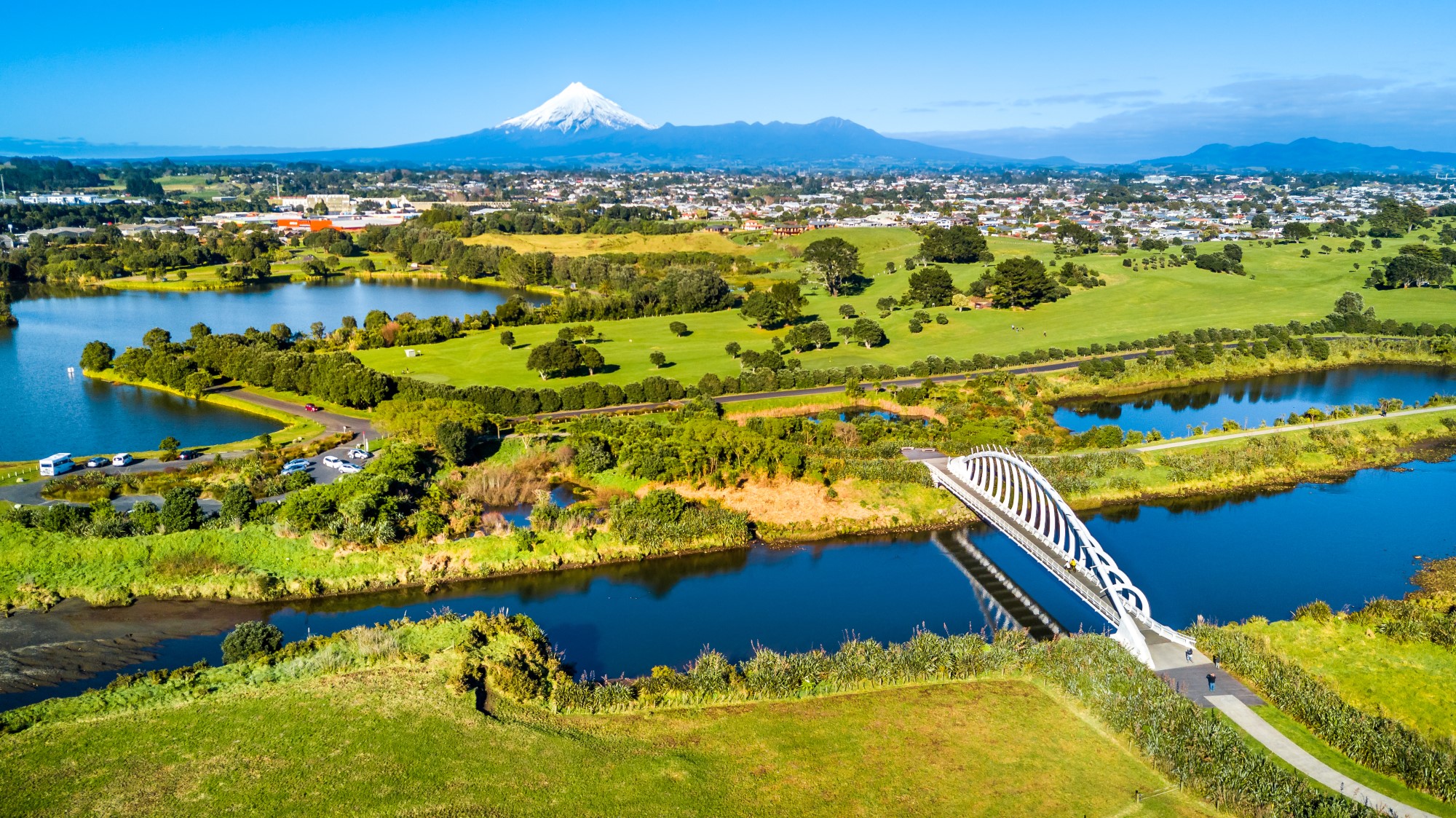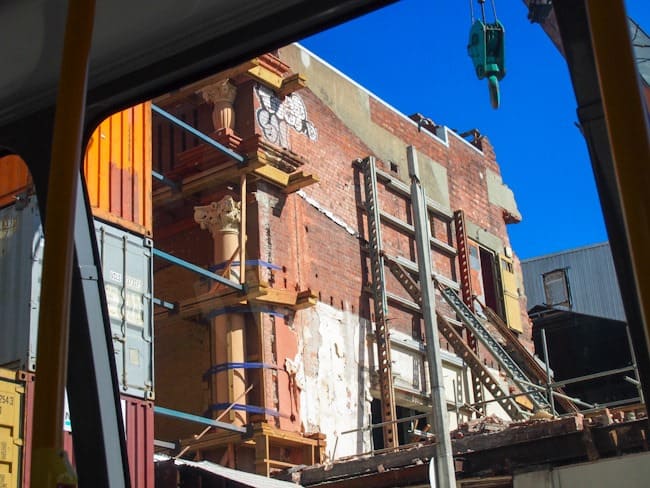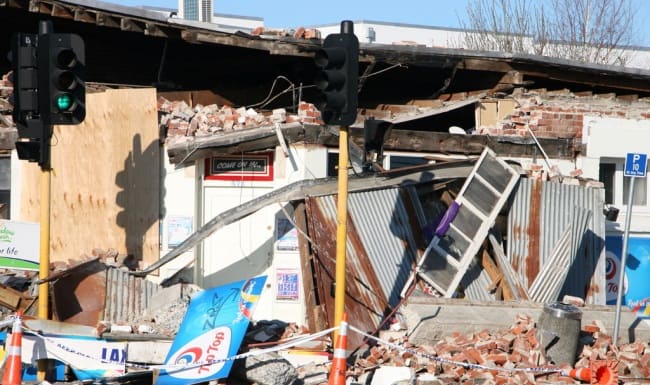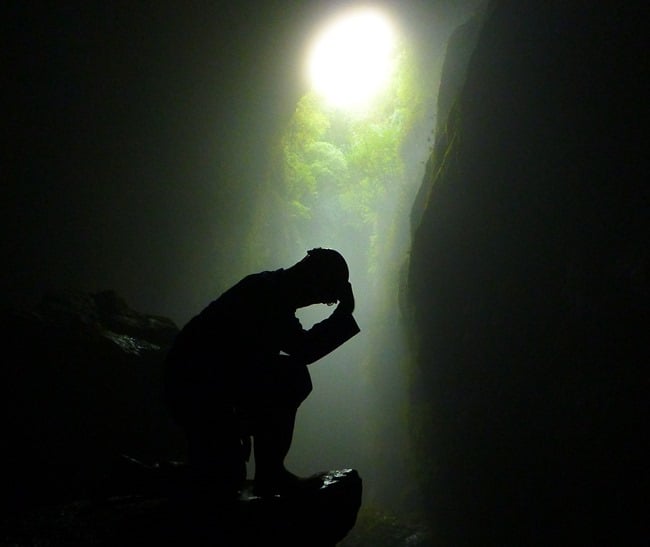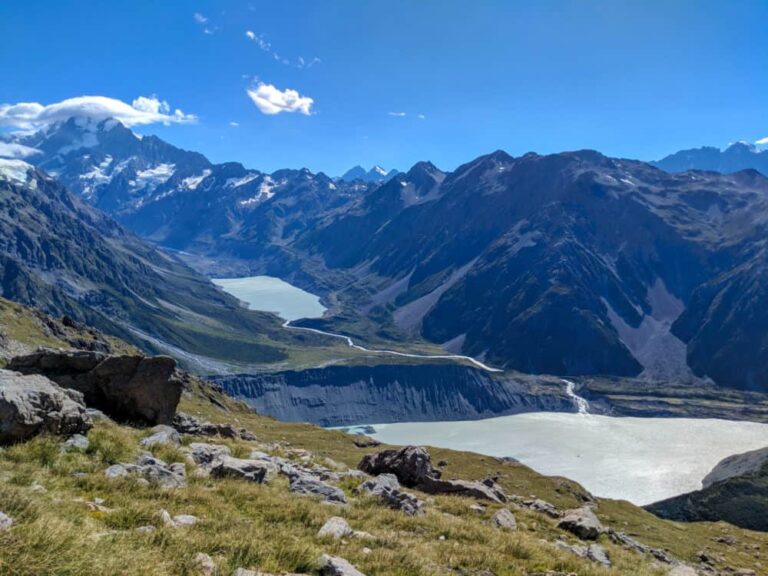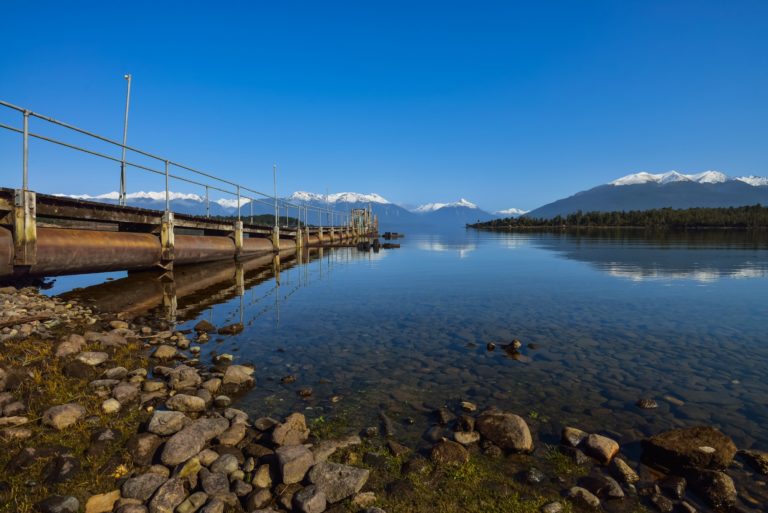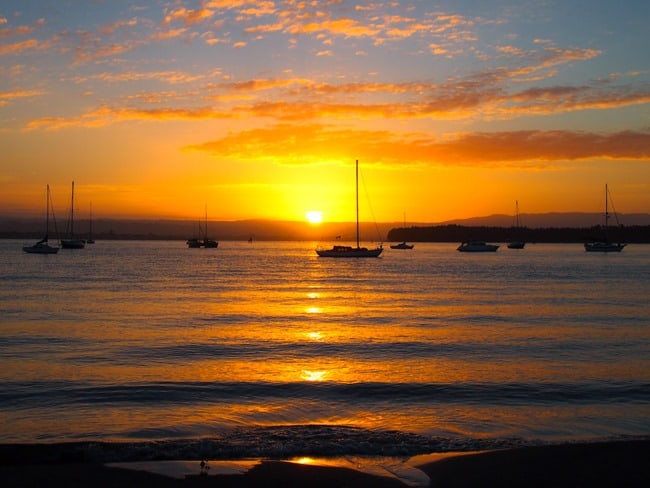13 Great Things to Do in Taranaki
Articles on this site contain affiliate links, meaning I may be compensated if you buy a product or service after clicking them. The full privacy & disclosure policy is here.About halfway down the western coast of New Zealand’s North Island, Taranaki is a region of crashing surf, dense forests, and of course that towering volcano that gives the region its name. All of this, combined with a laid-back country atmosphere, makes it surprising that the area isn’t more popular with overseas visitors.
Sparsly populated, only 126,000 people are scattered across the 724,000 hectares of the Taranaki region: just one person per six hectares! Where there are no people, you’ll see plenty of farmland: almost half a million cows also live here, and you’ll spot black and white Friesians everywhere!
Mount Taranaki, one of New Zealands more famous landmarks, rises in a near-perfect cone shape from the center of a large open plain. This dormant volcano is approximately 125,000 years old, and is the subject of a well-known Māori legend that explains how it came to be here.
Taranaki once lived in the central North Island with the mountains Ruhepeu, Ngaruhoa, and Tongariro. Taranaki and Tongariro both fell in love with and fought over the maiden Pihanga. Taranaki lost the fight, and fled to his current location. His flight path can still be seen, the mighty Whanganui River!
Most visitors arrive via State Highway 3, from either the north or the south. It’s worth branching off onto SH45 as soon as you can, though: this beautiful coastal drive sees less traffic, and takes you past empty beaches and the wild Tasman sea.
As well as its famous mountain and stunning coastline, the area also has several animal parks, beautiful gardens, and scenery that is unmistakably New Zealand in nature. For culture buffs, galleries feature the work of prominent local artists, and multiple museums showcase various aspects of the country’s history.
Whether you’re looking to hike the iconic mountain trails, enjoy the beauty of the region’s empty beaches and dense native bush, or get a taste of the quirky culture that’s unique to this rural heartland, Taranaki certainly lives up to its tourism slogan: “Like No Other”.
Taranaki often records the most sunshine hours of any region in New Zealand, so there’s a good chance you’ll even have decent weather while you’re there!
Explore Brooklands Park
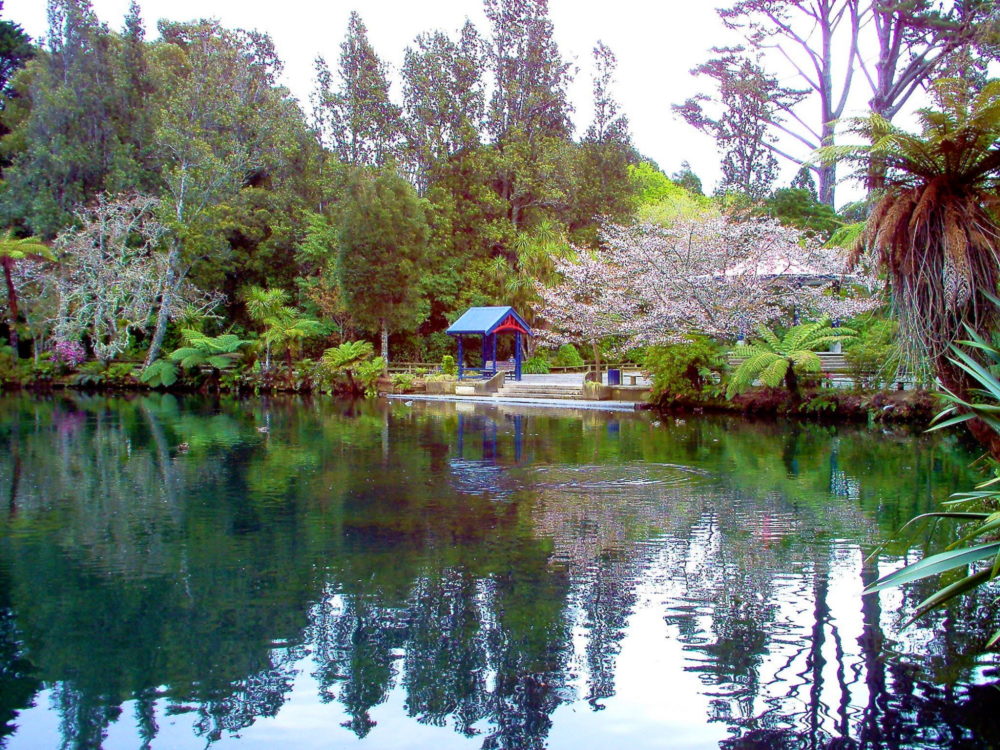
New Plymouth is the largest town in the Taranaki region, and right in the centre sits Brooklands Park. A beautiful pond surrounded by lush bush is the main drawcard of this 52-hectare park, but you’ll find a little of everything here: great art, cute animals, lovely walks, and an impressive little cafe to replenish your energy when you’re done.
Begin your visit in Brooklands Zoo. It’s free to enter, and the zookeepers give informative talks twice a day at weekends and during school holidays. You’ll get to see a range of farm animals, plus otters, monkeys, various reptiles, and parrots.
Right next door is Gables Colonial Hospital Art Gallery, a beautiful historical building full of local art and crafts and ever changing exhibitions. People have even reported seeing ghostly faces in the upper windows, although I haven’t spotted them myself… yet.
From here wander around the lake, taking a walk in Tom Cruise’s footsteps: this area provided one of the sets for the movie “The Last Samurai”. There are multiple easy, well-signposted walks through the kind of lush scenic bush that’s rare to find in the middle of a major town, even in New Zealand.
Halfway around the pond sits the Tea House on the Lake, a quaint little cafe with a good range of meal and drink options. Once you’ve satisfied your tastebuds, head over to The Fernery and Display houses, and walk through the network of greenhouses with rare plants, funky art displays, and beautiful gardens.
Check Out the Arts and Crafts Scene in Ōakura
About 15 minutes down the coast from New Plymouth sits Ōakura, a beautiful little seaside town. From huge architecturally-designed mansions to ramshackle little baches (holiday homes) that look like they were largely made from whatever washed up on the beach that day, the architecture here is as diverse and eclectic as its residents.
For a stereotypical Kiwi summer experience, pick up some traditional Kiwi-style fish and chips and then wander down to the beach to eat them and enjoy the view. Once that’s done, take a walk along the main street and pop into the Crafty Fox: a number of artists make their homes and livelihoods in Ōakura, and there’s a good chance you’ll find some of their work inside.
Situated inside a hundred-year-old Anglican church, the owners, Tony and John, opened shop in 2001, and love to chat about their wares.
For something really special, head about three minutes inland to find Ring Craft Moana, a jeweler selling a range of beautiful handcrafted jewelry. They offer an unusual experience with behind-the-scenes tours, and also run workshops to make a ring of your own (bookings are essential for the latter).
As you head into or out of town to the south, detour to the end of Weld Road Lower and take a short walk along the beach to the skeletal remains of the SS Gairloch. This ship ran aground in 1903 while trying to avoid a collision with another coastal steamer, and at low tide you’re able to walk around what’s left of the wreck, and take photos of its ancient bones.
Take a Hike in the Kitake Ranges
Further south along the coast sit the Kitake Ranges, a smaller mountain range on the northwest side of Mt Taranaki that’s well worth a visit. It’s the only place you’ll find a significant amount of lowland coastal forest in the Taranaki, with the remainder of the native bush being highland mountain forest.
Heading south from Ōakura, take a left off State Highway 45 onto Upper Ahu Ahu Road, then drive up to Lucy’s Gully. It’s worth packing a lunch to in the picnic area here, surrounded by native bush and birdsong. Native trees like puriri and nikau palms abound, and there’s even a a stand of protected redwood nearby, along with plenty of beautiful ferny undergrowth.
From here, you can walk up into the mountains along the Sefton or Waimoku Tracks. These two tracks form a loop, joining up around 2km (uphill) from Lucy’s Gully. Note that these tracks are steep in places, so you’ll need to be reasonably fit. Expect the loop to take around a couple of hours to complete.
If you’re feeling particularly adventurous, keep walking uphill from the junction of these two tracks to the Putuha trig station and Kaitake Peak. This will add another two hours to your hike and is quite steep, including a rocky section you’ll need to scramble up, but at the top you will be rewarded with beautiful views both out to sea and up Mt Taranaki.
Head Up (or Around) the Mountain
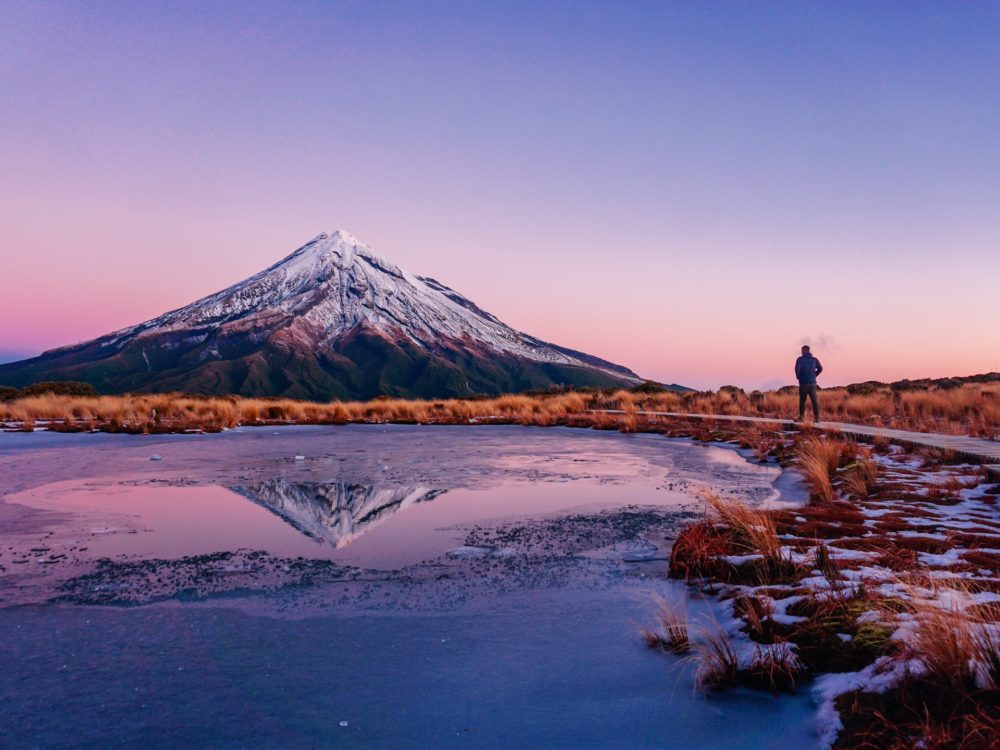
Taranaki’s jewel in the crown, it feels like Mount Taranaki is visible (on a clear day) from just about anywhere in the region.
On the northeast slopes of the mountain, the North Taranaki/Egmont visitor center is as close as you can get to the summit by vehicle. Run by the Department of Conservation (DoC), the friendly staff have plenty of information about the mountain and surrounding area, as well as the several walks that start nearby.
With over 300km of hiking (tramping) tracks throughout this area, all fitness and experience levels are covered. The trek to the summit takes a full day (8-10 hours) to complete and requires expert mountaineering experience and equipment outside the summer months, but the spectacular views are worth the effort.
For the less experienced, though, various shorter walks provide a more accessible option. The Veronica Loop Track, for instance, takes a couple of hours, and sees you walk up through native bush to a clearly-marked junction, then back down through the Hall’s tōtara forest to the visitors center.
At the junction, you have the option to keep going up the track for about ten minutes to a lookout point, with some breathtaking views. If you have any breath left to take at that point.
Looing for a multiday walk? The Around the Mountain Circuit is a great option for experienced hikers. With serviced huts along the route, this walk takes 4-5 days to complete, and is chock-full of of breathtaking New Zealand scenery, extensive bush views, and plenty of good mountain air. Note that one of the huts (at Lake Dive) burned down in 2020, so until it’s rebuilt, you’ll need to carry camping equipment to use for that night.
Walks, Waterfalls, and Waterholes
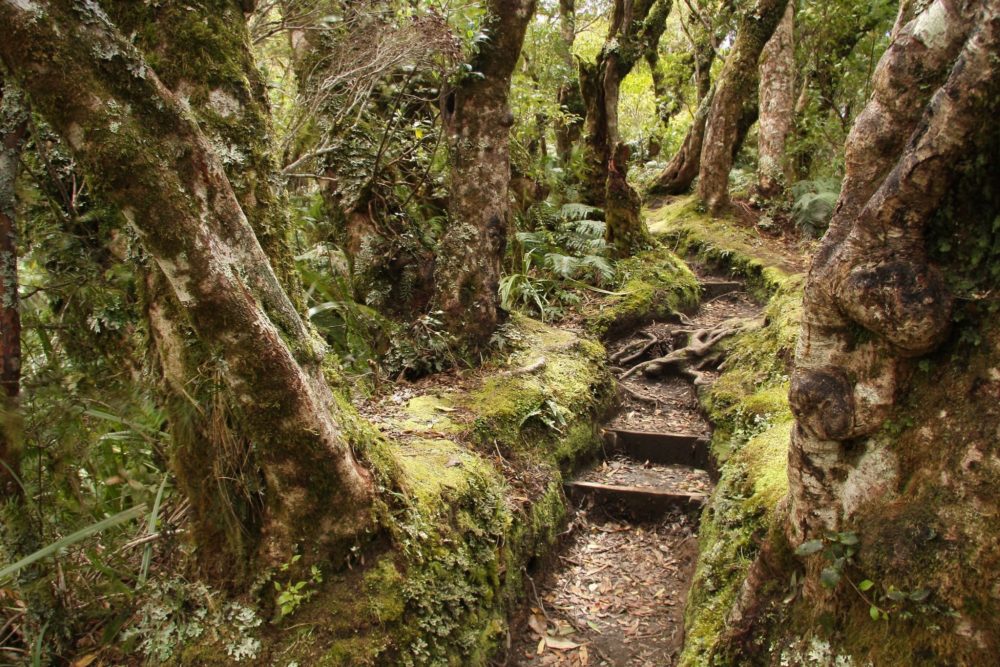
Another great spot to explore the mountain, Dawson Falls Visitor Centre is on the southeast flank. Not as busy as the Northern Visitors Center, you’ll find it at the end of winding Manaia Road, easily accessible from Stratford to the east and Opunake to the west.
Walks from here range from beginner to advanced. One of the easiest is the stroll to Dawson Falls itself: the trailhead is just five minutes back down the road from the visitor centre carpark, and it’s only ten minutes from there to either the base of the falls or a lookout point above it.
The Around the Mountain Circuit can also be accessed from here, along with a range of other walks lasting anywhere from an hour to a full day. Of those, Wilkies Pools Loop Track is particularly worthwhile, a roughly hour-long loop from the carpark that’s mostly easy walking through the forest. Enjoy the views and take a dip in the pools before heading back, and be sure to check out the small waterfalls and bubbling springs along the way.
If a more manicured nature experience is your thing, Holland Gardens are only a short drive from the centre, just outside the national park. These public gardens are free to enter, and on a clear day you’ll get great views of the mountain. It’s worth visiting regardless of the weather, though, with the native rainforest and edible gardens being particular highlights.
Learn How Lighthouses Work
Back on the coast near Warea, take a detour to the end of Bayleys Road and the Historic Cape Light and Museum, a smaller replica of the original Cape Egmont lighthouse that still stands further down the coast.
You can’t go inside the original, however, but no such problem at the replica, where you can get up close to the light and learn all about how lighthouses work. No other lighthouse in New Zealand is open to the public, so this is your opportunity.
Downstairs, you will find an exhibit about Sir Ernest Rutherford, the New Zealand physicist made famous when he first split the atom. Rutherford spent much of his time in Taranaki region in his youth. Run by volunteers, opening hours are nominally Saturday to Monday, 11am-3pm, but these are subject to change.
Behind the museum, you can explore the rocky coast being hammered with wild Tasman waves. Battle the winds sweeping in from the Tasman Sea: this is as far west as you can get on this island.
Head Back in Time at Pioneer Village
After filling your lungs with mountain air and your eyes with scenic views, head south through Stratford to the Pioneer Village on the outskirts of town.
With 10 acres of historical buildings including a church, court house, railway station, and several cottages, it’s the closest you’ll get to transporting yourself back to early colonial New Zealand.
Read the stories of Taranaki’s pioneers, and jump on board the replica train for a ride around the entire property. Once you have had your fill of history, grab a meal or something to drink at the lovely onsite cafe.
Shakespeare in Stratford
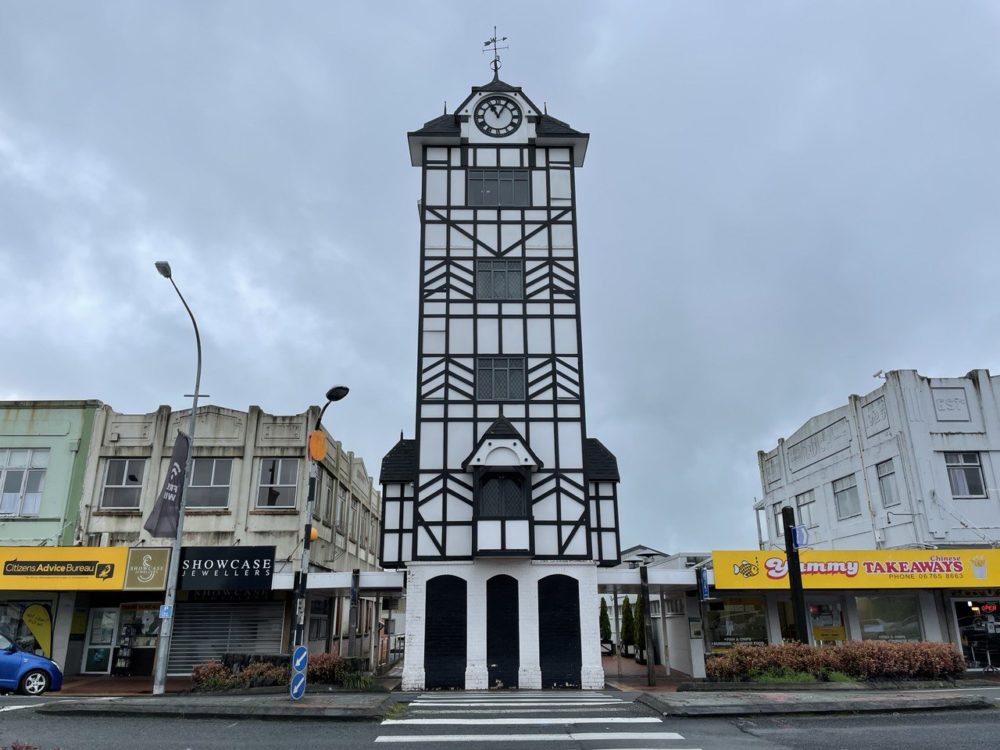
Speaking of Stratford, this small town in the eastern Taranaki makes the most of its association with Shakespeare’s birthplace in the UK. Most of the streets are named after Shakespearean characters, and even though Romeo and Juliet Streets don’t cross (a missed opportunity if ever there was one), it makes for some amusing photos as you stroll down Hamlet Street or Orsino Place.
On the main street sits New Zealand’s one and only glockenspiel clock tower, which you’d assume has nothing to do with Shakespeare whatsoever. That’s where you’d be wrong: four times a day, at 10am, 1pm, 3pm and 7pm, Romeo and Juliet emerge for a few minutes to perform the famous balcony scene. Because of course they do.
Once you’re done with Stratford’s literary allusions, it’s time for more practical matters. The town is a good place to refuel both yourself and your vehicle: there are several good places to eat (I enjoyed my breakfast at Azure Cafe), and if you’re heading east, it’s the last petrol stop before you get to Taumarunui, 150km down the Forgotten World Highway.
Swimming, Beaches and… Elvis?
Another of Taranaki’s larger towns, Hawera is well worth a visit. Māori heritage is strong here, with a number of marae and historic pā (Māori village). Keep an eye out for the water tower in the park on the corner of High and Albion Streets as well: it looks like it could be part of an old English castle!
It’s a good place to eat and drink, with a good range of restaurants and cafes, and there’s an aquatic center complete with waterslides to keep the kids entertained. If you’d rather not pay the $4-5 entry fee, head just out of town to Normanby Weir swimming hole instead. The entrance path is marked by three rocks: don’t blink as you drive along Normanby Road or you’ll miss it!
On the other side of town, drive out to the end of Denby Road where you can freedom camp (in certified self-contained vehicles), but also walk down the steep cliff steps to beautiful Waihi Beach. It’s usually an isolated spot, and you’ll feel like the last person on earth as you gaze out across the vast ocean with rocky cliffs looming behind you.
If you’ve got a bit of extra time, you can continue to walk along the coastline for about two and a half hours (return) via the Coastal Walkway, exploring the cliffs and unusual rock formations along the way.
On your way back into town, make sure you look in on KD’s Elvis Presley Museum, showcasing over sixty years of extensive collecting by Kevin Wasley. As a private museum you need an appointment, but Kevin loves to regale visitors with tales of how his Elvis collection came to be! Entry is free, although donations are appreciated.
Visit One of the Best Little Musuems in the Country
Just south of Hawera lies Tawhiti Museum, which is privately owned by artist and history enthusiast Nigel Ogle. His large-scale works of art build dramatic scenes that bring New Zealand history to life, and this little museum is one of New Zealand’s best-kept secrets.
Split into a number of themed galleries, you’ll walk through a range of scenes that illustrate key moments and activities from New Zealand’s past. Each piece is lovingly created by Nigel and crafted into a dynamic display that brings each moment to life in incredible detail.
The museum is open to the public Friday through Monday from spring to autumn, every day between Boxing Day and the end of January, and Sundays only in winter (June-August). If you happen to be in town on the first Sunday of each month, you’ll get to enjoy a dramatic presentation of the logging history of Taranaki on the Tawhiti Bush Railway.
Tickets cost $15 per adult, and $5 for children.
Get Some Beach Time in Opunake
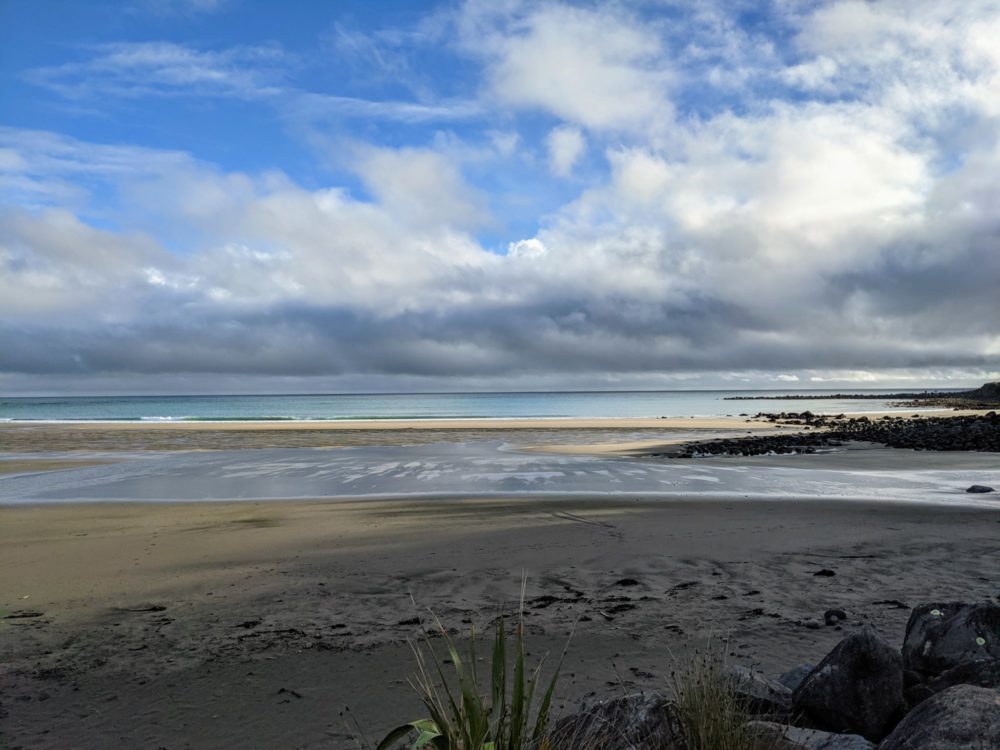
When you look up traditional Kiwi summer holiday spots in the dictionary, there may as well just be a photo of Opunake. A long stretch of sand, shallow water perfect for the kids to splash around in all day, and a large holiday camp alongside to pitch a tent or spend a few nights in a cabin.
Even if you’re not spending a week under canvas with the kids, Opunake is worth a look. Work on your tan for a while, then grab a coffee or brunch at Sugar Juice Cafe, which was easily my favourite daytime eating spot in town. There’s also a couple of pubs and convenience stores, and weirdly, two Four Square grocery stores within 100m of each other on the main street. If you can’t find what you need in one of them, it’s not exactly far to the other.
If you need to stretch your legs a little more than just the stroll between the grocery stores, I enjoyed the 7km walking route (the Opunake Loop Pathway) that takes you past a pretty lake and up onto the cliffs that overlook the bay. As the name suggests, it’s a loop, but you can get on or off at a number of different points depending on your time and energy levels.
Pukeiti
Out in the middle of nowhere about a half-hour drive south of New Plymouth, lies Pukeiti. These free botanic gardens are an unexpected delight, full of shaded trails through lush rainforest and one of the largest rhododendron collections in the world.
I went there on what started out an overcast, drizzly morning, and loved the moody vibe as water dripped from the overhanging leaves. By the time I left a couple of hours later, the sun was shining brightly, turning the gardens into a bright, colourful wonderland.
The walking was easy and enjoyable, with a range of well-marked, intersecting trails to suit all energy levels, including one aimed specifically at kids. There’s a good cafe at the entrance to the gardens, along with a multimedia centre full of useful information, and even a fitness trail that takes you around a range of exercise stations if walking alone doesn’t raise your heartrate enough!
Whether you’re coming from the north or south, you’ll spend the last few minutes of your drive to Pukeiti on Carrington Road, a beautiful (if narrow and winding) stretch of tarmac. Take it slow and enjoy the views!
Ashley Park
Heading in or out of Taranaki from the south? Stop in at Ashley Park. Owned and operated by local iwi (Māori tribe), visiting the park is a fun family experience that also helps support New Zealand’s indigenous people.
The animal park includes large aviaries with many well known and rare breeds of bird, while the farm walk has a number of lovely gentle animals that can be hand-fed. Of particular note are the tame deer, an unusual inclusion in a petting zoo.
Swim in the pool, play a round of minigolf, and check out the curiosities in their small “Memory Lane” museum that’s focused on the history of logos and toys. There’s also a tennis court and an extensive garden to explore, with well-established paths around the grounds and lake.
If you’d like to spend longer here, Ashley Park has accommodation options for all budgets, from hotel-level luxury to chalets on the lake and simple campgrounds.
Opunake image via author, Stratford glockenspiel via Lauren, Brooklands Park via denisbin, Mount Taranaki via CHUN FEI CHIN, Dawson Falls track via itravelNZ®,
,

